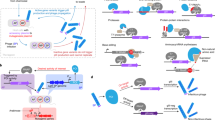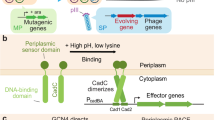Abstract
We report the development of soluble expression phage-assisted continuous evolution (SE-PACE), a system for rapidly evolving proteins with increased soluble expression. Through use of a PACE-compatible AND gate that uses a split-intein pIII, SE-PACE enables two simultaneous positive selections to evolve proteins with improved expression while maintaining their desired activities. In as little as three days, SE-PACE evolved several antibody fragments with >5-fold improvement in expression yield while retaining binding activity. We also developed an activity-independent form of SE-PACE to correct folding-defective variants of maltose-binding protein (MBP) and to evolve variants of the eukaryotic cytidine deaminase APOBEC1 with improved expression properties. These evolved APOBEC1 variants were found to improve the expression and apparent activity of Cas9-derived base editors when used in place of the wild-type cytidine deaminase. Together, these results suggest that SE-PACE can be applied to a wide variety of proteins to rapidly improve their soluble expression.
This is a preview of subscription content, access via your institution
Access options
Access Nature and 54 other Nature Portfolio journals
Get Nature+, our best-value online-access subscription
$29.99 / 30 days
cancel any time
Subscribe to this journal
Receive 12 print issues and online access
$259.00 per year
only $21.58 per issue
Buy this article
- Purchase on Springer Link
- Instant access to full article PDF
Prices may be subject to local taxes which are calculated during checkout





Similar content being viewed by others
References
Braun, P. & LaBaer, J. High throughput protein production for functional proteomics. Trends Biotechnol. 21, 383–388 (2003).
Socha, R. D. & Tokuriki, N. Modulating protein stability - directed evolution strategies for improved protein function. FEBS J. 280, 5582–5595 (2013).
Rosano, G. L. & Ceccarelli, E. A. Recombinant protein expression in Escherichia coli: advances and challenges. Front. Microbiol. 5, 172 (2014).
Terpe, K. Overview of bacterial expression systems for heterologous protein production: from molecular and biochemical fundamentals to commercial systems. Appl. Microbiol. Biotechnol. 72, 211–222 (2006).
Esposito, D. & Chatterjee, D. K. Enhancement of soluble protein expression through the use of fusion tags. Curr. Opin. Biotechnol. 17, 353–358 (2006).
Giver, L., Gershenson, A., Freskgard, P.-O. & Arnold, F. H. Directed evolution of a thermostable esterase. Proc. Natl Acad. Sci. USA 95, 12809–12813 (1998).
Cherry, J. R. et al. Directed evolution of a fungal peroxidase. Nat. Biotechnol. 17, 379–384 (1999).
Sieber, V., Plückthun, A. & Schmid, F. X. Selecting proteins with improved stability by a phage-based method. Nat. Biotechnol. 16, 955–960 (1998).
Khersonsky, O. et al. Directed evolution of serum paraoxonase PON3 by family shuffling and ancestor/consensus mutagenesis, and its biochemical characterization. Biochemistry 48, 6644–6654 (2009).
Waldo, G. S., Standish, B. M., Berendzen, J. & Terwilliger, T. C. Rapid protein-folding assay using green fluorescent protein. Nat. Biotechnol. 17, 691–695 (1999).
Waldo, G. S. Genetic screens and directed evolution for protein solubility. Curr. Opin. Chem. Biol. 7, 33–38 (2003).
Yuan, L., Kurek, I., English, J. & Keenan, R. Laboratory-directed protein evolution. Microbiol. Mol. Biol. Rev. 69, 373–392 (2005).
Rakonjac, J. & Model, P. Roles of pIII in filamentous phage assembly. J. Mol. Biol. 282, 25–41 (1998).
Badran, A. H. & Liu, D. R. Development of potent in vivo mutagenesis plasmids with broad mutational spectra. Nat. Commun. 6, 8425 (2015).
Carlson, J. C., Badran, A. H., Guggiana-Nilo, D. A. & Liu, D. R. Negative selection and stringency modulation in phage-assisted continuous evolution. Nat. Chem. Biol. 10, 216–222 (2014).
Dickinson, B. C., Leconte, A. M., Allen, B., Esvelt, K. M. & Liu, D. R. Experimental interrogation of the path dependence and stochasticity of protein evolution using phage-assisted continuous evolution. Proc. Natl Acad. Sci. USA 110, 9007–9012 (2013).
Esvelt, K. M., Carlson, J. C. & Liu, D. R. A system for the continuous directed evolution of biomolecules. Nature 472, 499–503 (2011).
Dickinson, B. C., Packer, M. S., Badran, A. H. & Liu, D. R. A system for the continuous directed evolution of proteases rapidly reveals drug-resistance mutations. Nat. Commun. 5, 5352 (2014).
Packer, M. S., Rees, H. A. & Liu, D. R. Phage-assisted continuous evolution of proteases with altered substrate specificity. Nat. Commun. 8, 956 (2017).
Hubbard, B. P. et al. Continuous directed evolution of DNA-binding proteins to improve TALEN specificity. Nat. Methods 12, 939–942 (2015).
Badran, A. H. et al. Continuous evolution of Bacillus thuringiensis toxins overcomes insect resistance. Nature 533, 58–63 (2016).
Bryson, D. I. et al. Continuous directed evolution of aminoacyl-tRNA synthetases. Nat. Chem. Biol. 13, 1253–1260 (2017).
Grodberg, J. & Dunn, J. J. ompT encodes the Escherichia coli outer membrane protease that cleaves T7 RNA polymerase during purification. J. Bacteriol. 170, 1245–1253 (1988).
Shis, D. L. & Bennett, M. R. Library of synthetic transcriptional AND gates built with split T7 RNA polymerase mutants. Proc. Natl Acad. Sci. USA 110, 5028–5033 (2013).
Betton, J.-M. & Hofnung, M. Folding of a mutant maltose-binding protein of Escherichia coli which forms inclusion bodies. J. Biol. Chem. 271, 8046–8052 (1996).
Chun, S.-Y., Strobel, S., Bassford, P. Jr & Randall, L. L. Folding of maltose-binding protein. Evidence for the identity of the rate-determining step in vivo and in vitro. J. Biol. Chem. 268, 20855–20862 (1993).
Roodveldt, C., Aharoni, A. & Tawfik, D. S. Directed evolution of proteins for heterologous expression and stability. Curr. Opin. Struct. Biol. 15, 50–56 (2005).
Schaerli, Y., Gili, M. & Isalan, M. A split intein T7 RNA polymerase for transcriptional AND-logic. Nucleic Acids Res. 42, 12322–12328 (2014).
Rakonjac, J. Filamentous bacteriophages: biology and applications. in Encyclopedia of Life Sciences (John Wiley & Sons, Ltd., Chichester, UK (2012)).
Shah, N. H., Dann, G. P., Vila-Perelló, M., Liu, Z. & Muir, T. W. Ultrafast protein splicing is common among cyanobacterial split inteins: implications for protein engineering. J. Am. Chem. Soc. 134, 11338–11341 (2012).
Zettler, J., Schütz, V. & Mootz, H. D. The naturally split Npu DnaE intein exhibits an extraordinarily high rate in the protein trans-splicing reaction. FEBS Lett. 583, 909–914 (2009).
Brissette, J. L., Weiner, L., Ripmaster, T. L. & Model, P. Characterization and sequence of the Escherichia coli stress-induced psp operon. J. Mol. Biol. 220, 35–48 (1991).
Wojcik, J. et al. A potent and highly specific FN3 monobody inhibitor of the Abl SH2 domain. Nat. Struct. Mol. Biol. 17, 519–527 (2010).
Holliger, P. & Hudson, P. J. Engineered antibody fragments and the rise of single domains. Nat. Biotechnol. 23, 1126–1136 (2005).
Wörn, A. & Plückthun, A. Stability engineering of antibody single-chain Fv fragments. J. Mol. Biol. 305, 989–1010 (2001).
Hanes, J., Jermutus, L., Weber-Bornhauser, S., Bosshard, H. R. & Plückthun, A. Ribosome display efficiently selects and evolves high-affinity antibodies in vitro from immune libraries. Proc. Natl Acad. Sci. USA 95, 14130–14135 (1998).
der Maur, A. A. et al. Direct in vivo screening of intrabody libraries constructed on a highly stable single-chain framework. J. Biol. Chem. 277, 45075–45085 (2002).
Waraho-Zhmayev, D., Meksiriporn, B., Portnoff, A. D. & DeLisa, M. P. Optimizing recombinant antibodies for intracellular function using hitchhiker-mediated survival selection. Protein Eng. Des. Sel. 27, 351–358 (2014).
Lecerf, J.-M. et al. Human single-chain Fv intrabodies counteract in situ huntingtin aggregation in cellular models of Huntington’s disease. Proc. Natl Acad. Sci. USA 98, 4764–4769 (2001).
Gilbreth, R. N., Esaki, K., Koide, A., Sidhu, S. S. & Koide, S. A dominant conformational role for amino acid diversity in minimalist protein-protein interfaces. J. Mol. Biol. 381, 407–418 (2008).
Harris, R. S., Petersen-Mahrt, S. K. & Neuberger, M. S. RNA editing enzyme APOBEC1 and some of its homologs can act as DNA mutators. Mol. Cell 10, 1247–1253 (2002).
Komor, A. C., Kim, Y. B., Packer, M. S., Zuris, J. A. & Liu, D. R. Programmable editing of a target base in genomic DNA without double-stranded DNA cleavage. Nature 533, 420–424 (2016).
Nishida, K. et al. Targeted nucleotide editing using hybrid prokaryotic and vertebrate adaptive immune systems. Science 353, aaf8729 (2016).
Gaudelli, N. M. et al. Programmable base editing of A•T to G•C in genomic DNA without DNA cleavage. Nature 551, 464–471 (2017).
Rees, H. A. et al. Improving the DNA specificity and applicability of base editing through protein engineering and protein delivery. Nat. Commun. 8, 15790 (2017).
Seo, M. J. et al. Engineering antibody fragments to fold in the absence of disulfide bonds. Protein Sci. 18, 259–267 (2009).
Jespers, L., Schon, O., Famm, K. & Winter, G. Aggregation-resistant domain antibodies selected on phage by heat denaturation. Nat. Biotechnol. 22, 1161–1165 (2004).
Bloom, J. D., Labthavikul, S. T., Otey, C. R. & Arnold, F. H. Protein stability promotes evolvability. Proc. Natl Acad. Sci. USA 103, 5869–5874 (2006).
Acknowledgements
This work was supported by US NIH NIBIB R01EB022376, NIGMS R35 GM118062, NHGRI RM1 HG009490, Monsanto, and the Howard Hughes Medical Institute. T.W. is a Ruth L. Kirchstein National Research Service Awards Postdoctoral Fellow (F32 GM119228).
Author information
Authors and Affiliations
Contributions
T.W. designed the research, performed the experiments, analyzed data, and wrote the manuscript. A.H.B. designed the research, analyzed data, and wrote the manuscript. T.P.H. performed and analyzed the mammalian cell base editing experiments. D.R.L. designed and supervised the research and wrote the manuscript.
Corresponding author
Ethics declarations
Competing interests
The authors have filed a provisional patent application on the PACE system and related improvements.
Additional information
Publisher’s note: Springer Nature remains neutral with regard to jurisdictional claims in published maps and institutional affiliations.
Supplementary information
Supplementary Text and Figures
Supplementary Tables 1–6, Supplementary Figures 1–19, Supplementary Note 1
Rights and permissions
About this article
Cite this article
Wang, T., Badran, A.H., Huang, T.P. et al. Continuous directed evolution of proteins with improved soluble expression. Nat Chem Biol 14, 972–980 (2018). https://doi.org/10.1038/s41589-018-0121-5
Received:
Accepted:
Published:
Issue Date:
DOI: https://doi.org/10.1038/s41589-018-0121-5
This article is cited by
-
Targeting Efficient Features of Urate Oxidase to Increase Its Solubility
Applied Biochemistry and Biotechnology (2024)
-
High-throughput continuous evolution of compact Cas9 variants targeting single-nucleotide-pyrimidine PAMs
Nature Biotechnology (2023)
-
Engineering a Minimal Leucine-rich Repeat IgG-binding Module
Applied Biochemistry and Biotechnology (2022)
-
In vivo hypermutation and continuous evolution
Nature Reviews Methods Primers (2022)
-
A systematic approach to inserting split inteins for Boolean logic gate engineering and basal activity reduction
Nature Communications (2021)



